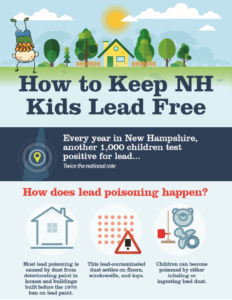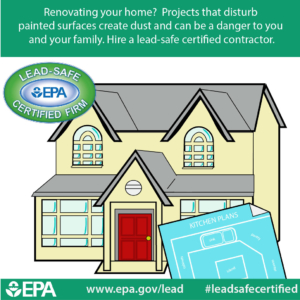Taking on Childhood Lead Poisoning
 Beginning in 2018, New Hampshire state law has required doctors to test all one and two-year old children for lead poisoning. New Hampshire has been acutely vulnerable to lead poisoning in the past by virtue of the fact that 62% of New Hampshire housing stock was built before the ban on lead paint began in 1978[1]. This along with a high prevalence of unsafe renovation practices resulted in over 800 New Hampshire children tested positive for elevated blood lead levels (EBLL) in 2018. Lebanon and Enfield proved to be the two towns with the greatest prevalence of EBLL within the Upper Valley region. (Between 2014 and 2018, Lebanon reported 19 children and Enfield 9, with all other regions reporting 1-4 children, a value indicating insufficient reports of EBLL, according to Lead Exposure Brief Upper Valley 2018).
Beginning in 2018, New Hampshire state law has required doctors to test all one and two-year old children for lead poisoning. New Hampshire has been acutely vulnerable to lead poisoning in the past by virtue of the fact that 62% of New Hampshire housing stock was built before the ban on lead paint began in 1978[1]. This along with a high prevalence of unsafe renovation practices resulted in over 800 New Hampshire children tested positive for elevated blood lead levels (EBLL) in 2018. Lebanon and Enfield proved to be the two towns with the greatest prevalence of EBLL within the Upper Valley region. (Between 2014 and 2018, Lebanon reported 19 children and Enfield 9, with all other regions reporting 1-4 children, a value indicating insufficient reports of EBLL, according to Lead Exposure Brief Upper Valley 2018).
No Cure. No Treatment.
It only takes a pinch of lead dust or chips to cause irreversible harm to a young child’s developing brain. EBLL has been linked to lower IQ levels, increasing impulsivity and aggression, and difficulties with attention and executive functioning. It is also linked to poor visual, spatial, speech, and motor skills. One in every 5 Attention Deficit Disorder case is attributed to lead exposure. Children from birth to age six are vulnerable because they have not developed a blood-brain barrier yet and lead travels easily from the blood stream into the brain.
The impact of childhood lead poisoning extends beyond an individual’s health. Subsequent to the Flint Water Crisis, Michigan saw a 56% increase in special education budgets. This burden on taxpayers is compounded by the way our current lead-abatement system operates—by placing the burden of cost and remediation on landlords and property managers.
Gathering for Local Action
In an effort to create a regionally based, early intervention system, the Public Health Council collaborated with the NH Healthy Homes and Lead Poisoning Prevention Program to create conversation about lead poisoning in the region. We believe that if the many players involved with lead poisoning and abatement collaborated more effectively, we would be able to reduce the frequency of lead poisoning and simultaneously reduce costs in our region through various educational and training opportunities.
On September 27th, 2019, the Public Health Council hosted an educational presentation facilitated by Ms. Gail Gettens from the Healthy Homes and Lead Poisoning Prevention Program. Ms. Gettens presented an overview of the negative impacts of lead on cognitive and behavioral health as well as the current New Hampshire laws and protocols for screening and BLL testing. After the educational session, the Public Health Council’s Executive Director, Alice Ely, facilitated a stakeholder-planning meeting with the hopes of using our region’s assets to create actionable plans. We hope the plans from this meeting, together with the current traction established through the requirement of lead screening for 1 and 2 year old children, has the potential to create positive change in the Upper Valley.
There was a diverse array of stakeholders in attendance at this September meeting. Industry affiliations included building trades, child-care givers, city government officials, community leaders, legislators, health care providers, housing personnel, landlords and property managers, regional planning commission members, and school district/special education members.
Planning Local Initiatives
Based on the success of this gathering and the quality of the plan that emerged, the Public Health Council was awarded a grant through the New Hampshire Healthy Homes and Lead Prevention Program. Funding will be available in February 2020 to support a two-pronged approach to improving the Upper Valley’s lead prevention plan.
First, we will expand training and certification opportunities for local homeowners, contractors, landlords, property managers and town building inspectors. We will host at least  two training sessions using the Environmental Protection Agency’s (EPA) Renovate, Repair and Paint (RRP) lead safe work practices. This approach was determined as a necessary step due to the majority of New Hampshire’s housing stock having lead-based paint. Many believe there are too few RRP contractors in the Upper Valley region, which decreases the likelihood that lead-safe work practices will be used on renovation projects. The Public Health Council aims to host RRP training sessions of eight hours each between March and September 2020, with the hopes of reaching 45 homeowners, contractors, landlords, property managers or town building inspectors.
two training sessions using the Environmental Protection Agency’s (EPA) Renovate, Repair and Paint (RRP) lead safe work practices. This approach was determined as a necessary step due to the majority of New Hampshire’s housing stock having lead-based paint. Many believe there are too few RRP contractors in the Upper Valley region, which decreases the likelihood that lead-safe work practices will be used on renovation projects. The Public Health Council aims to host RRP training sessions of eight hours each between March and September 2020, with the hopes of reaching 45 homeowners, contractors, landlords, property managers or town building inspectors.
Secondly, the Public Health Council plans to collaborate with the Mascoma Valley Regional School District (MVRSD) through its Superintendent, School Board members, Special Education Director, other school personnel, and parents to change school policy. MVRSD has over 200 students with disabilities (nearly 20% of their student body) but do not have a clear understanding of how many of these children have been affected by lead poisoning.
The lack of awareness on the severity and impact of lead poisoning has prompted the Superintendent of MVRSD to partner with the Public Health Council to host an educational session for parents and school personnel and lead poisoning, as well as change school policy to require documentation of blood lead level tests for school registration. The Mascoma Community Health Center will also work with us to increase blood lead level screening in the region. We expect to host the educational event in March of 2020, and see a new school policy adopted by December 2020.
As other strategy opportunities emerge, the Public Health Council will look for partners and resources to implement them. For example, with the help of a Dartmouth College Eichler Fellow, we expect to create a webpage and a webpage template with important information about lead-safe practices that towns and other organizations in our region can use to educate their constituents.
— Submitted by Claire Thomas, Dartmouth College ’82 Upper Valley Community Impact Fellow
[1] 2018 Lead exposure Data Brief for Upper Valley Region, NH Division of Public Health Services.




Leave a Reply
Want to join the discussion?Feel free to contribute!